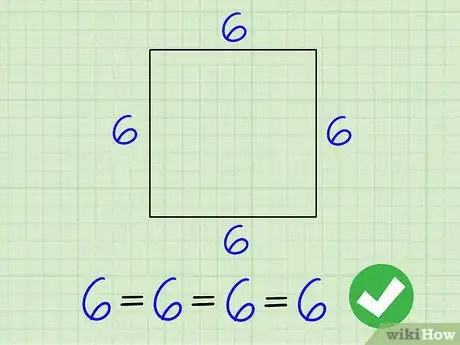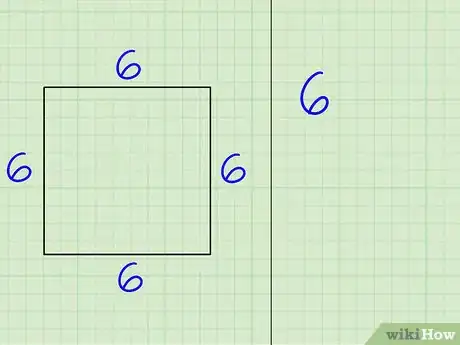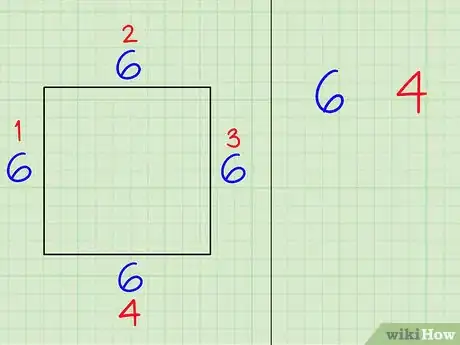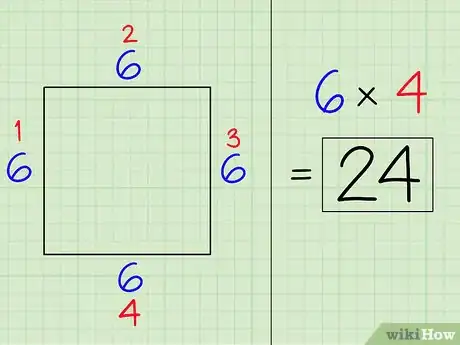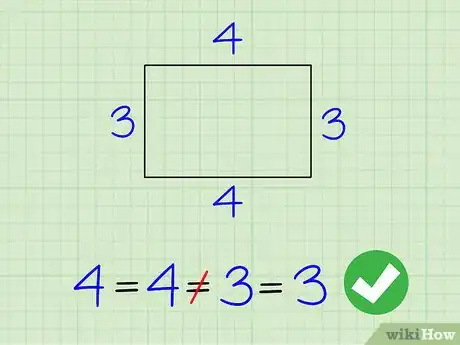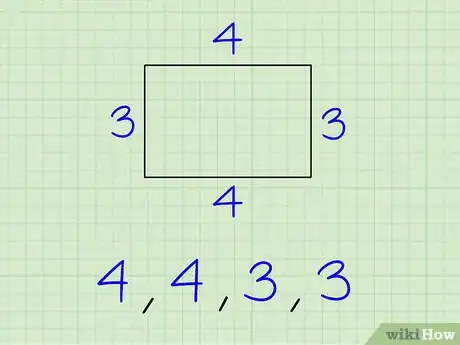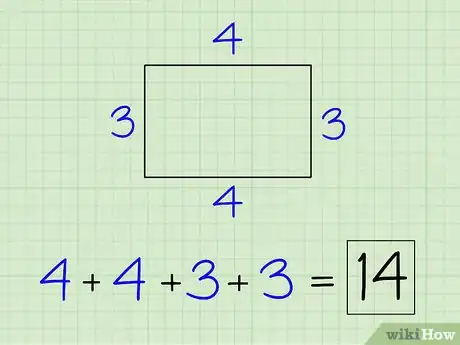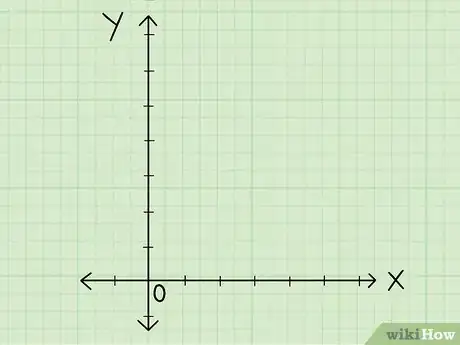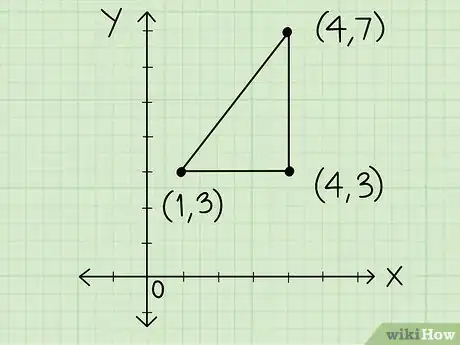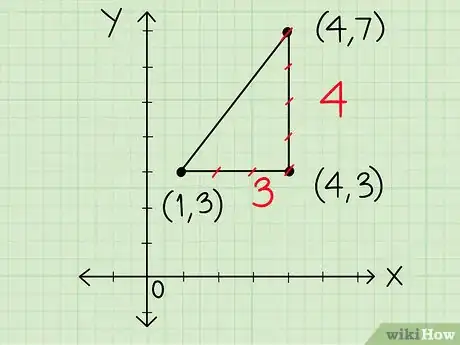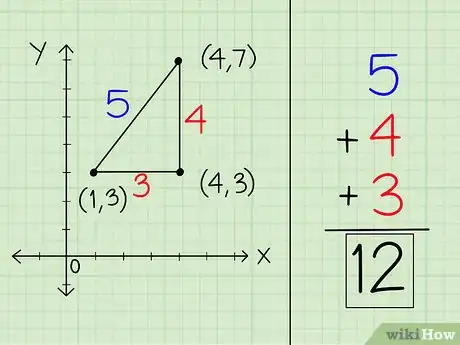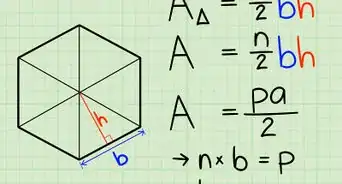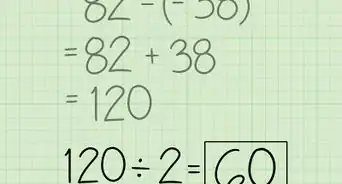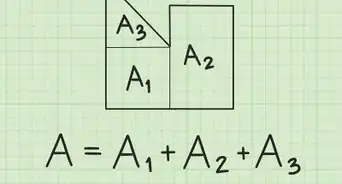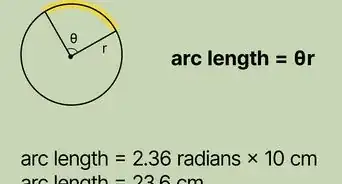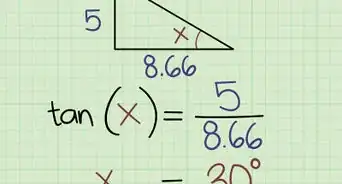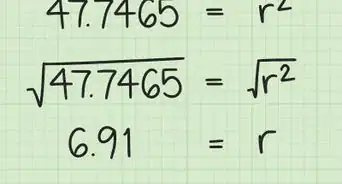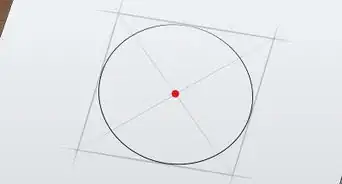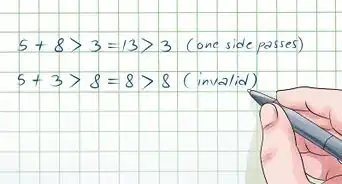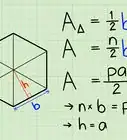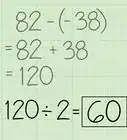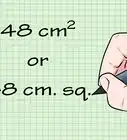This article was co-authored by wikiHow staff writer, Kyle Hall. Kyle Hall works on the content team at wikiHow. He helps manage our team of editors and creates content for a variety of wikiHow projects. Kyle continually looks for new ways to improve the content at wikiHow and make it more helpful and enjoyable for readers. He graduated from Eckerd College in 2015, where he majored in Political Science.
There are 7 references cited in this article, which can be found at the bottom of the page.
This article has been viewed 153,193 times.
Learn more...
A polygon is any two-dimensional shape that has straight lines. There are both regular polygons, which are shapes with equal sides, and irregular polygons, which are shapes with different side lengths. The methods for finding the perimeter of regular and irregular polygons are a little different, but both are simple once you know what to do. You can also find the perimeter of them on a coordinate grid. If you're trying to find the perimeter of a regular polygon, just use the formula: perimeter = number of sides x the length of any side.
Steps
Finding the Perimeter of a Regular Polygon
-
1Check that the sides of the polygon are all the same length. Regular polygons are polygons that have equal sides. If the sides of the polygon you’re looking at aren’t all the same length, you’ll need to find the perimeter using the method for irregular polygons instead. If the side lengths are equal, you’re working with a regular polygon.[1]
Tip: If some of the sides aren't labeled, try looking at the rest of the polygon to determine what the lengths are. For example, if you have a square with only 1 labeled side, you know the other sides are the same length since squares have equal sides.
-
2Write down the length of 1 side of the polygon. It doesn’t matter which side you choose since all of the side lengths are equal. Just make sure you’re only writing down the length of 1 side.[2]
- For example, if you're working with a square that has a side length of 6, you would write down “6.”
Advertisement -
3Write down the total number of sides that the polygon has. Don’t worry about the side lengths at this point. Just count how many sides the polygon has and write it down.[3]
- For a square, you’d write down “4” since a square has 4 sides.
-
4Multiply the side length by the number of sides to get the perimeter. The formula for finding the perimeter of a regular polygon is just the number of sides x the length of any side. Once you’ve multiplied those 2 numbers together, you’ve found the perimeter of the polygon![4]
- In the square example, you know that the square has a side length of 6 and a total of 4 sides. Therefore, you'd just multiply 6 by 4 to get 24, which would be the perimeter of the square.
- Or, say you were working with a triangle that has a side length of 3. Since a triangle has 3 sides, you would multiply 3 (the number of sides) by 3 (the side length) to get 9. Therefore, the perimeter of the triangle would be 9.
Calculating the Perimeter of an Irregular Polygon
-
1Look at the length of the polygon’s sides to determine if it’s irregular. An irregular polygon is a polygon that doesn’t have equal sides. If the sides of the polygon are all the same length, that means the polygon is regular, not irregular.[5]
Did you know? You can use the same method for finding the perimeter of an irregular polygon to find the perimeter of a regular polygon, but not the other way around.
-
2Write down the length of each side of the polygon. Since not all sides of an irregular polygon are equal, you’ll need to write out each individual side length. Even if some of the sides are equal, you should still write each length out individually.[6]
- For example, if you’re working with a rectangle that has 2 sides that are 4 units long and 2 sides that are 3 units long, you would write “4, 4, 3, 3.”
- If you’re working with an irregular polygon that has 1 side that’s 2 units, 1 side that’s 3 units, and 1 side that’s 4 units, you would write “2, 3, 4.”
-
3Add up all of the lengths to find the perimeter. To find the perimeter of an irregular polygon, all you need to do is find the total of all of its side lengths. Simply add up each side length that you wrote down to find the perimeter of the polygon![7]
- For example, if the side lengths for the polygon were 4, 4, 3, and 3, they would add up to 14. Therefore, 14 would be the perimeter of the polygon.
Determining Perimeter Using Given Coordinates
-
1Draw a coordinate grid with an x- and y-axis. A coordinate grid is a graph with an x- and y-axis that you can plot coordinates on. To draw a coordinate grid, get a piece of graph paper or draw your own grid lines on a blank piece of paper using a ruler. Then, draw a horizontal line through the middle for the x-axis and a vertical line down the center for the y-axis. Finally, number the points on each axis, starting with “0” where the x- and y-axis intersect.[8]
- When you number your grid, the numbers above and to the right of the 0 will be positive, while the numbers below and to the left of the 0 will be negative.
-
2Plot the given coordinates on the graph. You should have been given coordinates for each vertex, or angular point, of the polygon you’re trying to find the perimeter of. Each coordinate should look something like “(1,2)." Use the numbers you marked on the coordinate grid to plot each of the coordinates. When you’re finished, connect the points with straight lines to see the shape of the polygon you’re working with.[9]
Tip: When plotting coordinates, remember that the first number represents the x-axis and the second number represents the y-axis. For example, if you were plotting (2,4), you would count 2 over on the x-axis and 4 up on the y-axis and then mark where those 2 points meet on the grid.
-
3Find vertical and horizontal side lengths by counting the units. You’ll need to know the length of each side of the polygon to determine its perimeter. For vertical or horizontal sides, simply count how many units there are between the points on each end. Then, write down the number next to that side so you can refer to it later.[10]
- For example, if you’re trying to find the length of a horizontal side, start at one end and count the number of boxes between that point and the other end. If you counted 6, that would mean the length of that side is 6 units.
-
4Use the distance formula to find the length of diagonal sides. Unfortunately, you can’t count the units on a grid to find the length of diagonal sides like you can with vertical or horizontal sides. Instead, you’ll need to use the distance formula, which is . Just plug in the values of the x and y coordinates for the 2 points at the ends of the side you’re trying to find the distance of and solve to find the length.[11]
- For example, if you’re trying to find the distance (length) between 2 points with the coordinates (4,7) and (1,3), you would plug those coordinates into the formula and get
- Then, you would simplify the equation to get .
- Finally, you would solve and get 5. Therefore, the length of the side would be 5.
-
5Add the length of each side together to find the polygon’s perimeter. The perimeter of a polygon is equal to the sum of all of its side lengths. Once you’ve determined all of these lengths using the coordinates you were given, all you need to do is add them together and then you’re done!
- For example, if you plotted the coordinates of a triangle and found that the side lengths are 3, 2, and 5, you would add these numbers together to get 10. Therefore, the perimeter of the triangle is 10.
Community Q&A
Did you know you can get answers researched by wikiHow Staff?
Unlock staff-researched answers by supporting wikiHow
-
QuestionHow do you find the perimeter and area of a polygon?
 wikiHow Staff EditorThis answer was written by one of our trained team of researchers who validated it for accuracy and comprehensiveness.
wikiHow Staff EditorThis answer was written by one of our trained team of researchers who validated it for accuracy and comprehensiveness.
Staff Answer wikiHow Staff EditorStaff AnswerTo find the perimeter, add up the lengths of all the sides of the polygon. Finding the area can be a little more complicated, since it depends on what kind of shape you’re dealing with. To calculate the area of a regular polygon, multiply ½ x p (the perimeter) x a (the apothem, or the distance from the center of the polygon to the midpoint of any side). If the polygon is irregular, you’ll need to divide it up into regular shapes (e.g., a rectangle and a triangle), find the area of each part, and add them together.
wikiHow Staff EditorStaff AnswerTo find the perimeter, add up the lengths of all the sides of the polygon. Finding the area can be a little more complicated, since it depends on what kind of shape you’re dealing with. To calculate the area of a regular polygon, multiply ½ x p (the perimeter) x a (the apothem, or the distance from the center of the polygon to the midpoint of any side). If the polygon is irregular, you’ll need to divide it up into regular shapes (e.g., a rectangle and a triangle), find the area of each part, and add them together. -
QuestionHow do you find the perimeter of a weird shape?
 wikiHow Staff EditorThis answer was written by one of our trained team of researchers who validated it for accuracy and comprehensiveness.
wikiHow Staff EditorThis answer was written by one of our trained team of researchers who validated it for accuracy and comprehensiveness.
Staff Answer wikiHow Staff EditorStaff AnswerAs long as it’s made up of straight lines, finding the perimeter is as simple as adding up the lengths of all the sides. If there are curves involved, it can get a bit more complex! For instance, if your shape is made up of 3 straight sides and a semicircle, you’d need to add the 3 straight sides plus the arc length of the curved side (in the case of a semicircle, .5 x π x diameter of the semicircle).
wikiHow Staff EditorStaff AnswerAs long as it’s made up of straight lines, finding the perimeter is as simple as adding up the lengths of all the sides. If there are curves involved, it can get a bit more complex! For instance, if your shape is made up of 3 straight sides and a semicircle, you’d need to add the 3 straight sides plus the arc length of the curved side (in the case of a semicircle, .5 x π x diameter of the semicircle). -
QuestionHow do you find the perimeter if there’s a missing side?
 wikiHow Staff EditorThis answer was written by one of our trained team of researchers who validated it for accuracy and comprehensiveness.
wikiHow Staff EditorThis answer was written by one of our trained team of researchers who validated it for accuracy and comprehensiveness.
Staff Answer wikiHow Staff EditorStaff AnswerIt depends on the kind of shape you’re dealing with. If the polygon is all right angles, you can easily use the known lengths of the other sides to figure out the length of the missing side. If there are non-right angles, break down the shape into right-angled triangles and use the Pythagorean theorem (a^2+b^2=c^2) to solve for the missing lengths.
wikiHow Staff EditorStaff AnswerIt depends on the kind of shape you’re dealing with. If the polygon is all right angles, you can easily use the known lengths of the other sides to figure out the length of the missing side. If there are non-right angles, break down the shape into right-angled triangles and use the Pythagorean theorem (a^2+b^2=c^2) to solve for the missing lengths.
References
- ↑ https://www.mathopenref.com/polygonperimeter.html
- ↑ https://www.mathopenref.com/polygonperimeter.html
- ↑ https://www.mathsisfun.com/geometry/polygons.html
- ↑ https://www.mathopenref.com/polygonperimeter.html
- ↑ https://www.mathsisfun.com/geometry/polygons-interactive.html
- ↑ https://www.khanacademy.org/math/geometry-home/geometry-shapes/angles-with-polygons/v/sum-of-interior-angles-of-a-polygon
- ↑ https://www.youtube.com/watch?v=dlHyZ1Hme1s
- ↑ https://www.algebra.com/algebra/homework/Polygons/Polygons.faq.question.881850.html
- ↑ https://www.algebra.com/algebra/homework/Polygons/Polygons.faq.question.881850.html
About This Article
To find the perimeter of a regular polygon, which is a polygon with equal sides, start by writing down the length of 1 side and the total number of sides. Then, multiply those 2 numbers together to find the perimeter. If you're trying to find the perimeter of an irregular polygon, which is a polygon with different side lengths, start by writing down the length of each side. Then, simply add up all of the lengths to find the perimeter. To learn how to find the perimeter of a polygon using coordinates, scroll down!
